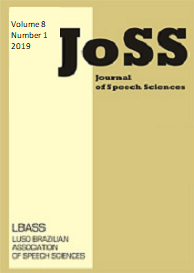Abstract
The present paper aims to analyze the role of prosody in the resolution of global ambiguity in sentences of the type NP1 - Verb - NP2 - Adverb of place - Adverb of intensity (very) - Attribute, e.g., “The guitarist received the drummer at the room very drugged” (O guitarrista recebeu o baterista no quarto bastante drogado), in Brazilian Portuguese (BP). We consider the hypothesis that prosodic cues, such as stress and pause, assist in the process of disambiguation, both in isolation and in conjunction. The experimental paradigm of the present study used an off-line method of linguistic processing through a questionnaire with Likert scale questions. The results revealed a predominance of non-local apposition judgments in all analyzed conditions. However, the choice of assigning the adjective to the first nominal phrase increased, in a statistically significant way, in the conditions in which there was prosodic manipulation for that purpose, confirmation our hypothesis.
References
Angelo, M. C. Produção e percepção na desambiguação de sentenças sintaticamente ambíguas do português brasileiro através da pista prosódica de duração. Dissertação de Mestrado, USP, São Paulo, 2016.
Boersma P, Weenink D. Praat: doing phonetics by computer (Version 6.0.36) [Computer program]. Disponível em: http://www.praat.org/. Acesso em: 20 de out. 2017.
Cozijn R. et al. The time course of the use of implicit causality information in the processing of pronouns: A visual world paradigm study. Journal of Memory and Language, 64 (4), 381-403, 2011.
Cuetos F, Mitchell DC. Cross-linguistic differences in parsing: Restrictions on the use of the Late Closure strategy in Spanish. Cognition, 30, 73-105, 1988.
Fernandes FR. Ordem, focalização e preenchimento em português: sintaxe e prosódia. Tese de doutorado, UNICAMP, Campinas, 2007.
Finger I, Zimmer MC. A preferência de interpretação de orações relativas curtas e longas em português brasileiro. In: M. Maia e I. Finger (Orgs.), Processamento da Linguagem, Pelotas: EDUCAT, 111-130, 2005.
Fodor JD. A Psicolinguística não pode escapar da prosódia. In: M. Maia e I. Finger (Orgs.), Processamento da Linguagem, Pelotas: EDUCAT, 91-110, 2005.
Fonseca AA. Pistas Prosódicas e o Processamento de sentenças ambíguas do tipo “SN1-V-SN2-Atributo” do Português Brasileiro. Dissertação de Mestrado, UFMG, Belo Horizonte, 2008.
Fonseca AA. O efeito do peso dos constituintes prosódicos da desambiguação de orações relativas reduzidas. ReVEL, 8 (15), 242-255, 2010.
Frazier L. On comprehending sentences: syntactic parsing strategies. PhD Dissertation, University of Connecticut, Indiana, 1979.
Frazier L, Clifton Jr C. Construal. Cambridge: MIT Press, 1996.
Frazier L, Rayner K. Making and correcting errors during sentence comprehension: eye movements in the analysis of structurally ambiguous sentences. Cognitive Psychology, 14, 178-210, 1982.
Gernsbacher MA., Hargreaves DJ. Accessing sentence participants: the advantage of first mention. Journal of Memory and Language, 27 (6), 699-717, 1988.
Kaiser E. Focusing on pronouns: consequences of subjecthood, pronominalisation, and contrastive focus. Language and Cognitive Processes, 26 (10), 1625-1666, 2011.
Magalhães JO, Maia M. Pistas prosódicas implícitas na resolução de ambigüidades sintáticas: um caso de adjunção de atributos. Revista da ABRALIN, 5 (1-2), 143-167, 2006.
Maia M. et al. Early and late preferences in relative clause attachment in Portuguese and Spanish. Journal of Portuguese Linguistics, 6 (1), 227-250, 2007.
Maia M. Teoria do Garden Path. 2009. Disponível em: http://psicolinguistica.letras.ufmg.br/wiki/index. php/Teoria_do_Garden_Path. Acesso em: 06 de jun. 2017.
Nespor M, Vogel I. Prosodic phonology: with a new foreword. Berlin: Mouton de Gruyter, 2007[1986].
Norman G. Likert scales, levels of measurement and the “laws” of statistics. Advances in Health Science Education, 15 (5), 625-632, 2010.
Pickering MJ, Traxler MJ. Plausibility and Recovery from Garden Paths: An Eye-Tracking Study. Journal of Experimental Psychology: Learning, Memory, and Cognition, 24 (4), 940-961, 1998.
Prieto P, Cohn A, Fougeron C, Huffman M. Experimental methods and paradigms for prosodic analysis. The Oxford Handbook of Laboratory Phonology. Oxford: Oxford University Press, 528-538, 2012.
Ribeiro AJC, Maia M, Finger I. Late Closure em Parsing no Português do Brasil. Processamento da Linguagem. Pelotas: EDUCAT, 51-70, 2005.
Schütze CT, Sprouse J, Podesva, Robert J, Sharma, Devyani. Research Methods in Linguistics. Cambridge: Cambridge University Press, 27-50, 2013.
Traxler MJ. Introduction to Psycholinguistics: understanding language science. Chichester: Wiley-Blackwell, 2012.
Wellmann C. et al. How each prosodic boundary cue matters: evidence from German infants. Frontiers in Psychology, 3, Art. 580, 2012.
Winter JCF, Dodou D. Five-Point Likert Items: t test versus Mann-Whitney-Wilcoxon. Practical Assessment, Research & Evaluation, 15 (11), 1-16, 2010.

This work is licensed under a Creative Commons Attribution 4.0 International License.
Copyright (c) 2020 René Alain Santana de Almeida, Miguel Oliveira Jr, Reinier Cozijn


